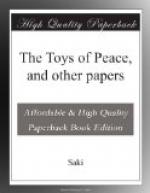“But the Suffragettes,” interrupted the nephew; “what did they do next?”
“After the bird fiasco,” said Sir Lulworth, “the militant section made a demonstration of a more aggressive nature; they assembled in force on the opening day of the Royal Academy Exhibition and destroyed some three or four hundred of the pictures. This proved an even worse failure than the parrot business; every one agreed that there was always far too many pictures in the Academy Exhibition, and the drastic weeding out of a few hundred canvases was regarded as a positive improvement. Moreover, from the artists’ point of view it was realised that the outrage constituted a sort of compensation for those whose works were persistently ‘skied’, since out of sight meant also out of reach. Altogether it was one of the most successful and popular exhibitions that the Academy had held for many years. Then the fair agitators fell back on some of their earlier methods; they wrote sweetly argumentative plays to prove that they ought to have the vote, they smashed windows to show that they must have the vote, and they kicked Cabinet Ministers to demonstrate that they’d better have the vote, and still the coldly reasoned or unreasoned reply was that they’d better not. Their plight might have been summed up in a perversion of Gilbert’s lines—
“Twenty voteless millions
we,
Voteless all against
our will,
Twenty years hence we shall be
Twenty voteless
millions still.”
And of course the great idea for their master-stroke of strategy came from a masculine source. Lena Dubarri, who was the captain-general of their thinking department, met Waldo Orpington in the Mall one afternoon, just at a time when the fortunes of the Cause were at their lowest ebb. Waldo Orpington is a frivolous little fool who chirrups at drawing-room concerts and can recognise bits from different composers without referring to the programme, but all the same he occasionally has ideas. He didn’t care a twopenny fiddlestring about the Cause, but he rather enjoyed the idea of having his finger in the political pie. Also it is possible, though I should think highly improbable, that he admired Lena Dubarri. Anyhow, when Lena gave a rather gloomy account of the existing state of things in the Suffragette World, Waldo was not merely sympathetic but ready with a practical suggestion. Turning his gaze westward along the Mall, towards the setting sun and Buckingham Palace, he was silent for a moment, and then said significantly, ’You have expended your energies and enterprise on labours of destruction; why has it never occurred to you to attempt something far more terrific?’




